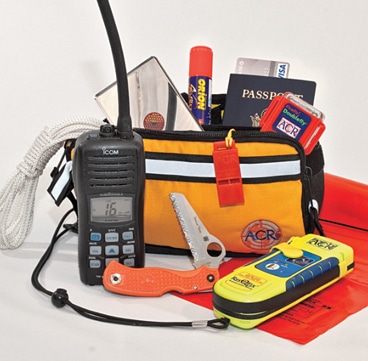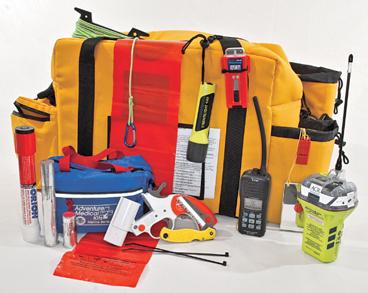
One minute you’re on your dream cruise, the next is your worst nightmare. Being prepared will likely make it a really good sea story. If you’re near the U.S. coast, being prepared might mean just having a personal locator beacon as well as a strobe light and signal mirror to help rescuers zero in once close. All this can be stuffed in pants pockets. If you’re farther from shore but still in range of quick rescue, a small belt pack with more essentials will leave your hands free.
If you cruise offshore, a proper abandon-ship bag keeps survival gear where it’s quick to grab. It could also provide redundant first-aid and emergency gear, along with a backup VHF and GPS for use after an electrical fire or lightning strike disables primary equipment.
Add to your ditch kit in the moments, or even hours, you’ll have before leaving the boat. Gather all the bottled water you can — there is never too much. The same holds true of warm clothing. Tie together everything that floats to increase visibility; a string of extra life jackets, for example, is easier to spot from the air than just a raft.
Basic Ditch Bag
- A PLB is a great backup to an EPIRB and easier to use inside a raft.
- A serrated knife should have a blunt tip, a lanyard and should open with one hand.
- Braided cord and tie wraps keep together what you can salvage.
- Once deployed, an orange rescue streamer continually signals.
- A strobe is the best nighttime signal and works well during the day. Some strobes double as flashlights.
- Flares and a signal mirror might be easier to see from sea level but require active use.
- If an airplane or merchant ship is first on scene, a waterproof handheld VHF with fresh batteries can be worth its weight in gold.
- Sunscreen and seasickness pills prevent dehydration.
- Pack extra prescription drugs and eyeglasses, reading glasses and sunglasses.
- Don’t forget cash, a credit card, identification and a plastic bag to keep your cell phone dry.

Offshore Ditch Bag
- Start with a floating, brightly colored bag and attach a strobe light.
- Attach a laminated checklist of additional equipment to grab if there’s time.
- Keep a couple of waterproof duffle bags handy, all with snap hooks to clip together.
- A knife, waterproof flashlight, braided line and tie wraps should be easy to reach yet secured to the bag.
- Eyeglasses and reading glasses also need to be quick to find.
- Have an EPIRB for the boat and a PLB for the ditch bag.
- Fit a handheld waterproof VHF and GPS with lithium batteries and carry spares.
- A small compass and watch are handy.
- A satellite phone is not a substitute for an EPIRB. If you have one, put Coast Guard numbers in speed dial and pack an extra battery and solar charger.
- Passive signals are best, such as a strobe light, floating rescue streamer and dye markers.
- Orange smoke flares, a signal mirror and a whistle draw attention in daylight.
- Red meteor or parachute flares, handheld locator flares and chemical light sticks work at night.
- Take seasickness medication immediately, but save water rations, survival food and hard candy.
- Add waterproof duct tape, medical shears and an indelible ink marker.
- Don’t overlook toilet paper, sanitary napkins, hand sanitizer and Ziplocs for gear and as vomit/waste bags.
- Polypropylene clothing, warm hats, gloves and two-person survival blankets help keep you warm.
- A bailer, bucket, sponge, washcloth, sunglasses, hats, sunscreen, aloe and light protective clothing all increase comfort.
- First-aid items include a pocket mask for rescue breathing, large pressure dressings and gauze, Silvadene for burns, a splint with self-adhering ace bandages, tweezers, medical shears, BZK towelettes to clean wounds, antibiotic ointment, waterproof bandages and tape.
- Add Tigan suppositories for severe vomiting, Imodium for diarrhea and prescription medications.
- Bring shoes for landing on rocks or reef, a waterproof fire starter and aluminum foil.
- Pack a small backpack or belt pack for helicopter or ship rescue with laminated photocopies of passports, immunization records, cash (small, new U.S. bills), traveler’s checks, a credit card, ship documents and insurance information, medication names and dosages and important phone numbers.
- Shipwreck survivors all wish they had a camera and notebook. One suggests a laminated copy of Rime of the Ancient Mariner.
The U.S. Coast Guard is asking all boat owners and operators to help reduce fatalities, injuries, property damage, and associated healthcare costs related to recreational boating accidents by taking personal responsibility for their own safety and the safety of their passengers. Essential steps include: wearing a life jacket at all times and requiring passengers to do the same; never boating under the influence (BUI); successfully completing a boating safety course; and getting a Vessel Safety Check (VSC) annually from local U.S. Coast Guard Auxiliary, United States Power Squadrons(r), or your state boating agency’s Vessel Examiners. The U.S. Coast Guard reminds all boaters to “Boat Responsibly!” For more tips on boating safety, visit www.uscgboating.org.








